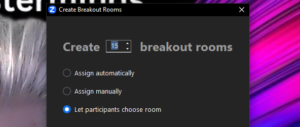I’ve seen it called “speed networking”, “speed meeting”, “business speed dating”, “rapid networking”, and event “speed dealing” (although that last one sounds like something you’d see at a casino.)
Whatever you call it, it is one of the simplest, most powerful tools in virtual networking.
You look at the number of participants on the Zoom, divide it by 2, and create that many rooms. Send people out for between 2 and 6 minutes (and there is an art to the different lengths), and let the magic happen.
I’d like to share a few keys of making it work and one fantastic story of how one event catastrophically overcomplicated things.
Setting Expectations for Rapid Networking
The first is setting expectations. In a rapid networking setting. People need to understand that they will not have a deep, insightful, powerful, life changing conversation in the course of a few minutes. What they will be able to do is get to know enough about their partner to know if it is worth setting up a follow up call where they can have a deep, insightful, powerful, life changing conversation.
If people go into these breakouts thinking they’re going to have a real conversation, they’ll be sorely disappointed, but if they’re going in with specific objectives, there will be enough time.
Fundamentally rapid networking is very simple:
Create breakouts.
Send people to breakouts.
Close breakouts.
Repeat.
If you want to get fancy, give people a chance to report back on their breakouts after two or three of them.
What Overcomplication Looks Like
What happens when we don’t keep it simple?
Let me tell you about something I saw at an event once…
We were told that we were going to do a rapid networking activity in 6 minute rounds. One person would speak 3 minutes then the other. So far so good. Pretty standard.
Half the attendees got an “A” put on their name and the other half a “B”. The As were to speak first and be in charge of the room. Still good.
We would then be manually assigned to breakout rooms by the host. The Bs would have to remember the number of the breakout room they were assigned to. When the notification came that the 6 minute were up, they were to use the self directed breakouts to move themselves to the next room.
Of course, if they were in the last room, they had to circle back to the first.
Follow so far?
The first thing that went wrong was that the support team set up the Zoom room wrong.

Instead of checking “Let participants choose room,” they checked “assign automatically.”
Most of the participants were already confused, and the fact that the virtual door was locked made to so much worse.
So then, they told all the Bs to just come back into the main room where they would manually assign them to their next room. Soon they realized that was not workable, so they closed all the rooms meaning that many people got 30 seconds then thrown back into the main room.
Finally, they configured the rooms correctly and we all went out.
So what? We still networked, right?
In a longer networking meeting, you have time to chat and feel your way into the conversation.
Rapid networking is more instinctual. You need to be on your game, attentive and focused. If you have 6 minutes, it takes 3 of those minutes to simply transmit the basic details of who you are, what you do, what you want. Then, in the brief remaining time, you need to be focused enough to get a sense of if you want to follow up with this person.
Then, of course, there’s about 15-30 seconds to actually consummate that choice, exchanging contact info or calendar links.
When you’re distracted by the confusing structure and system, part of your mind is worried about staying on schedule, what will happen next, and what is expected of you to keep things flowing.
Many people did not notice the notifications or didn’t know how to move to the next room, meaning you might be stuck with someone bumbling around the breakout controls, wasting valuable time from your opportunity to engage the next partner.
And the benefit of this complicated, convoluted, confusing system?
Nothing.
There was not benefit over the simple, tried and true, automated room placements.
Well, not no benefit. The host got to put their stamp on it, making it unique and like no other event.
Different is not always better.
Keeping it Simple, Doing it Right at JV Connect
At JV Connect, we will be keeping it simple, using tried and true, proven event structures for rapid networking, breakouts, and other program elements to put you in contact with the maximum number of a valuable potential contacts without straining your brain to figure out how to follow the process.
When we do rapid networking, all you have to think about is “is this person someone I can provide value to and who can provide value to me?” We’ll do the rest.
And by keeping it simple, you will be able to make valuable connections with as many as two, three, or even four right fit partners per hour.
Yes, I said per hour. Not per event. Not even per day. 2-4 per hour.
That means that you could come out of JV Connect with as many as 50 quality appointments with right fit partners on your calendar. That’s enough to keep you busy through the next JV Connect 3 months later!
That’s a pretty good return on investment, wouldn’t you say?
If you still need to register for JV Connect, you can do it here.
Keep up to date by joining the JV Connect Facebook group.